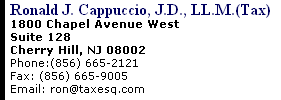
2006 Tax Law -
Part 3
What Your Company Needs to
Know |
Stabilizing
and strengthening traditional defined benefit pension plans
maintained by large employers was ostensibly the main reason
for the Pension Protection Act of 2006. The new
defined benefit pension rules are highly technical and not of
interest to everyone. Therefore, some of these provisions are
briefly summarized below,
|
New Law
Boosts Automatic 401(k) Plans
Does
your company have a 401(k) plan and employees who don't
participate? If so, you could make participation
“automatic” in the future. And, if employees are already
participating, their 401(k) contributions could be
increasing soon, even if they don’t lift a
finger.
It all has to do with several
key provisions in the new Pension Protection
Act. The new provisions generally take effect in
2008, but employers can implement changes before
then.
Here are the
details: Currently, most 401(k) plans
require employees to make a decision to participate. If
an employee elects to defer part of his or her salary by
making contributions, the employer might match the
contributions, in whole or in part, within the
prescribed tax law limits.
This can be a tough
sell for younger employees who aren’t worried about
retirement and lower-paid employees who don't have much
disposable income. Higher-paid employees may also be
constrained by nondiscrimination rules designed to
ensure that they don’t receive a disproportionate amount
of benefits under a plan.
In the
past, some employers have used an “automatic-enrollment”
feature to avoid these problems. Simply put,
participants are enrolled in the plan automatically
unless they choose not to be. The employer must meet
“safe-harbor” requirements to comply with the
nondiscrimination laws. (However, some states have
prohibited the use of such automatic
plans.)
The new law
overhauls the rules for automatic-enrollment 401(k)s.
For starters, it gives plans the official stamp of
approval on a nationwide level. Employers may limit the
automatic feature to new-hires or extend it to the
existing workforce as well. Although employees can still
choose to opt out of a plan, they may be more
likely to stick with it once they’re automatically
enrolled.
To further encourage retirement
savings, the new law makes it easier for employers to
automatically increase the percentage of an employee’s
salary directed to the account. For instance, an
employer may step up contributions from a minimum level
of 3 percent the first year to 4 percent the second
year, 5 percent the third and 6 percent in the fourth
year.
Note: The new act
does not, however, raise the tax law limits on amounts
that can be contributed annually by employers and
employees.
One side effect of
installing such a policy would be larger allowable
salary reduction contributions for higher-paid
employees, because lower-paid workers would be
contributing more.
Bottom line:
Both employers and employees should consult with their
professional advisers for the best approach to
take. |
|
|
|
New Rules for
Multi-Employer Plans
The Pension Protection Act establishes new
rules relating to multi-employer plans, including
identification of troubled plans, funding obligations
and actions required by trustees. Note: A plan
may be prohibited from increasing benefits if it could
jeopardize its financial
health. | along with other
important retirement plan changes.
- Stricter Funding Standards for Defined Benefit
Plans. The Pension Protection Act includes a
number of new provisions intended to encourage employers to
fully fund defined benefit pension plans. It also
discourages employers from promising or paying additional or
accelerated benefits for which adequate funding may not
exist. In general, underfunded plans are given seven years
to reach full funding. (Currently, plans are required to
cover only 90 percent of their liability.) Note:
New plans established after 2007 do not benefit from the
transitional rules.
- "At-risk" plans generally face accelerated
funding requirements. If a plan is treated as an
at-risk plan, it is required to accelerate contributions. A
plan is considered “at-risk” if it is less than 80 percent
funded without regard to at-risk liabilities and less than
70 percent funded counting at-risk liabilities. At-risk
liabilities are determined by assuming that employees
eligible to retire within the next ten years will retire at
the earliest date. (However, some underfunded airline and
other company plans are given longer to catch up.)
- Benefit limitations for "at risk"
plans. Employers that fall below the 80 percent
funding level are barred from providing enhanced or new
benefits. New accruals will be frozen in plans falling below
the 60 percent level. Note: Other restrictions may
apply to underfunded plans.
- Bigger Employer Deductions. To further encourage
full funding, the Pension Protection Act allows
employers to make larger deductible contributions to defined
benefit pension plans. The new rules allow employers to
contribute and write off amounts in excess of 100 percent of
current plan liabilities. (The calculations for deductions
is complex so consult with your tax adviser.) The new law
also permits larger deductible contributions by employers
that maintain defined benefit pension plans in tandem with
defined contribution plans.
- New Rules on Interest Rate Assumptions and Pension
Benefit Guaranty Corporation (PBGC) Premiums. The
Pension Protection Act establishes complex new
rules regarding interest rate assumptions that employers can
use to determine their defined benefit pension plan
liabilities and funding requirements. The new law also
includes revised rules for determining PBGC premiums.
- Earlier In-Service Distributions. The Pension
Protection Act allows defined benefit pension
plans to make distributions to employees who are still
working (so-called in-service distributions) after reaching
age 62. This change applies to plan years beginning after
2006.
- Better Protection for Spousal Beneficiaries.
The Pension Protection Act directs
the Department of Labor to issue updated rules that will
allow more flexibility in modifying qualified domestic
relations orders (QDROs). Also, some pension plans must
offer more generous joint-and-survivor annuity benefits to
surviving spouses.
- Faster Vesting Required for Non-Matching Employer
Contributions. For plan years beginning after 2006, the
Pension Protection Act mandates faster vesting
schedules for non-matching employer contributions to defined
contribution plans. These contributions will fall under the
same vesting schedules that already apply to employer
matching contributions.
- Liberalized Hardship Distribution Rules. The
Pension Protection Act directs the Treasury
Department to issue liberalized rules to allow 401(k)
hardship distributions based on hardships and unforeseen
financial problems faced by designated beneficiaries of plan
participants.
- Faster Diversification Out of Employer Stock. The
new law requires defined contribution plans to permit
employees to diversify more quickly out of employer stock
into alternative investments. Faster diversification must be
allowed for stock acquired with both employee elective
deferral (salary reduction) contributions and employer
contributions.
- Investment Advice Is Sometimes Allowed. Beginning
in 2007, retirement plan sponsors and fiduciaries are
allowed to hire and compensate “fiduciary advisers” to
supply investment advice and make investment transactions
for participants and beneficiaries of defined contribution
plans and beneficiaries of IRAs. A fiduciary adviser can be
a registered broker or dealer, a registered investment
adviser, a bank or similar financial institution, an
insurance company, or an affiliate, employee, agent or
representative of one of the above.
- Legal Protection for Conversions to Cash Balance
Plans. The new law provides legal protection to
employers who want to convert an existing traditional
defined benefit pension plan into a hybrid “cash balance”
plan. It insulates employers from age-discrimination
lawsuits by employees who could claim that such a switch
harms older workers.
This is just a brief overview of several key provisions in
the new law. Be aware that the law is extremely complex and
filled with numerous technical applications. Give me a call at
(856)665-2121 to discuss this in greater detail.
Click Here
for Part 1 of 2006 Act Changes
Click Here for
Part 2 of 2006 Act
Changes |  | |
|











